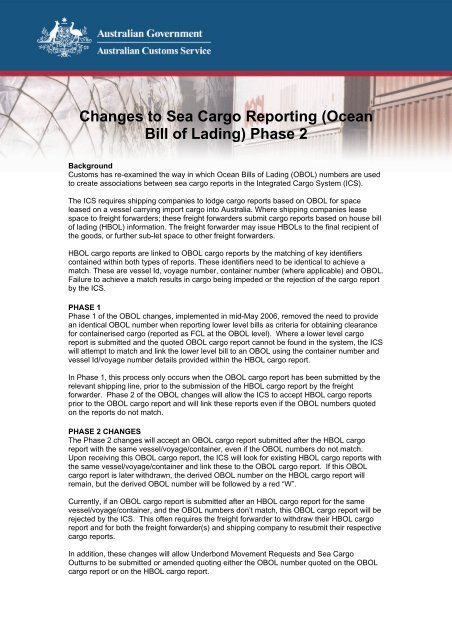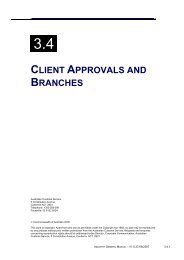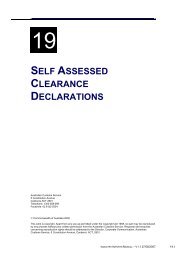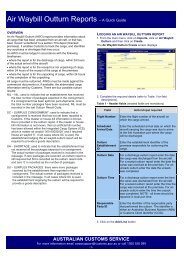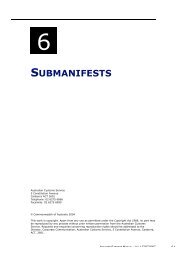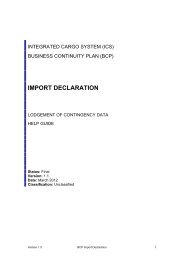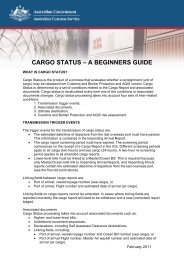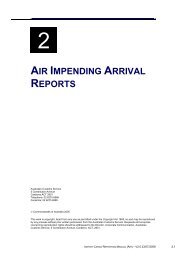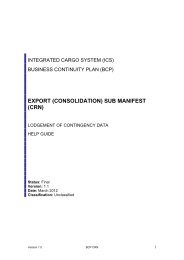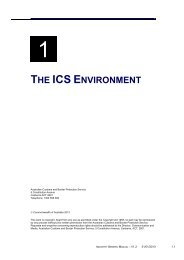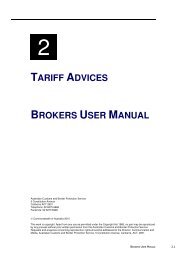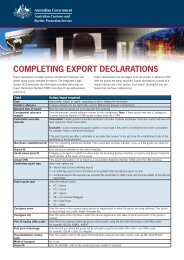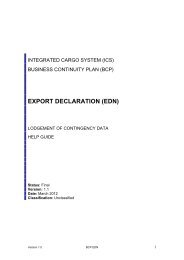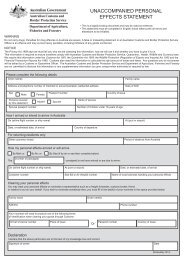Create successful ePaper yourself
Turn your PDF publications into a flip-book with our unique Google optimized e-Paper software.
<strong>Changes</strong> <strong>to</strong> <strong>Sea</strong> <strong>Cargo</strong> <strong>Reporting</strong> (Ocean<br />
Bill of Lading) Phase 2<br />
Background<br />
Cus<strong>to</strong>ms has re-examined the way in which Ocean Bills of Lading (OBOL) numbers are used<br />
<strong>to</strong> create associations between sea cargo reports in the Integrated <strong>Cargo</strong> System (ICS).<br />
The ICS requires shipping companies <strong>to</strong> lodge cargo reports based on OBOL for space<br />
leased on a vessel carrying import cargo in<strong>to</strong> Australia. Where shipping companies lease<br />
space <strong>to</strong> freight forwarders; these freight forwarders submit cargo reports based on house bill<br />
of lading (HBOL) information. The freight forwarder may issue HBOLs <strong>to</strong> the final recipient of<br />
the goods, or further sub-let space <strong>to</strong> other freight forwarders.<br />
HBOL cargo reports are linked <strong>to</strong> OBOL cargo reports by the matching of key identifiers<br />
contained within both types of reports. These identifiers need <strong>to</strong> be identical <strong>to</strong> achieve a<br />
match. These are vessel Id, voyage number, container number (where applicable) and OBOL.<br />
Failure <strong>to</strong> achieve a match results in cargo being impeded or the rejection of the cargo report<br />
by the ICS.<br />
PHASE 1<br />
Phase 1 of the OBOL changes, implemented in mid-May 2006, removed the need <strong>to</strong> provide<br />
an identical OBOL number when reporting lower level bills as criteria for obtaining clearance<br />
for containerised cargo (reported as FCL at the OBOL level). Where a lower level cargo<br />
report is submitted and the quoted OBOL cargo report cannot be found in the system, the ICS<br />
will attempt <strong>to</strong> match and link the lower level bill <strong>to</strong> an OBOL using the container number and<br />
vessel Id/voyage number details provided within the HBOL cargo report.<br />
In Phase 1, this process only occurs when the OBOL cargo report has been submitted by the<br />
relevant shipping line, prior <strong>to</strong> the submission of the HBOL cargo report by the freight<br />
forwarder. Phase 2 of the OBOL changes will allow the ICS <strong>to</strong> accept HBOL cargo reports<br />
prior <strong>to</strong> the OBOL cargo report and will link these reports even if the OBOL numbers quoted<br />
on the reports do not match.<br />
PHASE 2 CHANGES<br />
The Phase 2 changes will accept an OBOL cargo report submitted after the HBOL cargo<br />
report with the same vessel/voyage/container, even if the OBOL numbers do not match.<br />
Upon receiving this OBOL cargo report, the ICS will look for existing HBOL cargo reports with<br />
the same vessel/voyage/container and link these <strong>to</strong> the OBOL cargo report. If this OBOL<br />
cargo report is later withdrawn, the derived OBOL number on the HBOL cargo report will<br />
remain, but the derived OBOL number will be followed by a red “W”.<br />
Currently, if an OBOL cargo report is submitted after an HBOL cargo report for the same<br />
vessel/voyage/container, and the OBOL numbers don’t match, this OBOL cargo report will be<br />
rejected by the ICS. This often requires the freight forwarder <strong>to</strong> withdraw their HBOL cargo<br />
report and for both the freight forwarder(s) and shipping company <strong>to</strong> resubmit their respective<br />
cargo reports.<br />
In addition, these changes will allow Underbond Movement Requests and <strong>Sea</strong> <strong>Cargo</strong><br />
Outturns <strong>to</strong> be submitted or amended quoting either the OBOL number quoted on the OBOL<br />
cargo report or on the HBOL cargo report.
CONTAINERISED SEA CARGO REPORTING<br />
When an FCL OBOL cargo report is submitted <strong>to</strong> the ICS, the ICS will find all HBOL cargo<br />
reports for the same vessel/voyage/container (either FCL, FCX or LCL). If the OBOL<br />
numbers on the OBOL cargo report and HBOL cargo report(s) is the same, then the ICS will<br />
link these documents normally. If the OBOL numbers are different, the ICS will append the<br />
OBOL number from the OBOL cargo report <strong>to</strong> the HBOL cargo report and link these<br />
documents.<br />
Industry will still be required <strong>to</strong> continue <strong>to</strong> report the OBOL numbers provided on commercial<br />
documentation.<br />
<strong>Cargo</strong> reports may be amended or withdrawn, but unique cargo identifiers such as vessel Id,<br />
voyage number, OBOL number and HBOL number cannot be amended. If any unique cargo<br />
identifiers are required <strong>to</strong> be amended, the cargo report must be withdrawn and a new report<br />
submitted.<br />
Amendments <strong>to</strong>, or withdrawals of, HBOL cargo reports via EDI will be accepted only if the<br />
reported or derived OBOL number is quoted within the message.<br />
To clarify the matching process, there are a number of principles that will be applied when<br />
deriving an OBOL number for an HBOL cargo report:<br />
• If two or more OBOL cargo reports with the same vessel/voyage/container exist in the<br />
ICS when a matching HBOL cargo report is submitted, the HBOL cargo report will be<br />
linked <strong>to</strong> the OBOL cargo report that was submitted first;<br />
• If the linking of the HBOL cargo report <strong>to</strong> the OBOL cargo report will result in an<br />
impossible situation, such as an FCL HBOL cargo report becoming the child of an<br />
LCL HBOL cargo report, only the OBOL will only be derived for the HBOL cargo<br />
report that was submitted first; and<br />
• An OBOL cargo report will not be linked <strong>to</strong> an HBOL cargo report with the same<br />
vessel/voyage/container if the transit indica<strong>to</strong>rs on the two documents are different<br />
(i.e., one cargo report is for transit cargo and the other is for import cargo).<br />
SCENARIOS<br />
Scenario 1 (below) shows the system behaviour when:<br />
• The freight forwarder reports one HBOL cargo report for an FCL container using an<br />
inaccurate OBOL number;<br />
• The shipping company reports one OBOL cargo report for the FCL container<br />
consigned <strong>to</strong> the freight forwarder;<br />
• There is no underbond move required as the container is <strong>to</strong> be delivered from the<br />
wharf.<br />
Scenario 2 (below) shows the system behaviour when:<br />
• The freight forwarder reports one HBOL cargo report for an FCL container using an<br />
inaccurate OBOL number;<br />
• The shipping company reports one OBOL cargo report for the FCL container<br />
consigned <strong>to</strong> the freight forwarder, mistakenly quoting the incorrect OBOL number, so<br />
the OBOL cargo report is withdrawn, corrected and resubmitted;<br />
• There is no underbond move required as the container is <strong>to</strong> be delivered from the<br />
wharf.
CONTAINERISED OUTTURNS<br />
<strong>Sea</strong> <strong>Cargo</strong> Outturns at the HBOL level must quote either the OBOL number reported within<br />
the HBOL cargo report or the OBOL number that was derived from the OBOL cargo report.<br />
The ICS will recognise either of these OBOL numbers if quoted on a <strong>Sea</strong> <strong>Cargo</strong> Outturn and<br />
will process as normal. Amendments <strong>to</strong> <strong>Sea</strong> <strong>Cargo</strong> Outturns will be allowed using either the<br />
reported or derived OBOL number.<br />
SCENARIOS<br />
Scenario 3 (below) shows the system behaviour when:<br />
• The shipping company reports an OBOL cargo report for an FCL container consigned<br />
<strong>to</strong> a freight forwarder;<br />
• The freight forwarder reports one HBOL cargo report for an LCL consignment in that<br />
container using an inaccurate OBOL number;<br />
• The container is moved underbond from the wharf <strong>to</strong> a depot for deconsolidation<br />
• This depot submits a <strong>Sea</strong> <strong>Cargo</strong> Outturn report for the consolidation, quoting the<br />
freight forwarder’s inaccurate OBOL number for the LCL line<br />
LINE LEVEL UNDERBOND MOVEMENTS<br />
<strong>Sea</strong> <strong>Cargo</strong> Underbond Movements at line level must quote either the OBOL number reported<br />
within the HBOL cargo report or the OBOL number that was derived from the OBOL cargo<br />
report. The ICS will recognise either of these OBOL numbers if quoted on a <strong>Sea</strong> <strong>Cargo</strong><br />
Underbond Movement and will process as normal. Amendments <strong>to</strong> insert or delete a line<br />
within a <strong>Sea</strong> <strong>Cargo</strong> Underbond Movement will be allowed using either the reported or derived<br />
OBOL number.<br />
SCENARIOS<br />
Scenario 4 (below) shows the system behaviour when:<br />
• The freight forwarder reports an HBOL for an LCL container <strong>to</strong> the ICS using an OBOL<br />
number different <strong>to</strong> that issued by the shipping company<br />
• The shipping company reports the OBOL sea cargo report <strong>to</strong> the ICS using their OBOL<br />
number<br />
.<br />
• The container is moved underbond from the wharf <strong>to</strong> a depot for deconsolidation<br />
• An underbond movement request for a line within an LCL Container is submitted<br />
OUTBOUND MESSAGES<br />
There are no changes <strong>to</strong> Outbound Messages as a result of Phase 2 of the OBOL changes.<br />
ICS SCREEN CHANGES<br />
As a result of these changes there will be a number of changes <strong>to</strong> screens within the ICS<br />
Cus<strong>to</strong>ms Interactive. Cus<strong>to</strong>ms Interactive users will notice changes, detailed below, <strong>to</strong> the<br />
following screens:<br />
• <strong>Sea</strong> <strong>Cargo</strong> Report View<br />
• Underbond Movements View & Underbond Movements Line View<br />
• <strong>Sea</strong> <strong>Cargo</strong> Outturn View
SEA CARGO REPORT VIEW SCREEN<br />
As per the OBOL Phase 1 changes, when an OBOL number is derived for an HBOL cargo<br />
report this OBOL number will be displayed as the “Ocean Bill of Lading” on the <strong>Sea</strong> <strong>Cargo</strong><br />
Report View screen. If the OBOL cargo report is later withdrawn, the “Ocean Bill of Lading”<br />
on the <strong>Sea</strong> <strong>Cargo</strong> Report View screen will be updated with a red “W” <strong>to</strong> signify that the OBOL<br />
cargo report has been withdrawn.<br />
If a new OBOL <strong>Sea</strong> <strong>Cargo</strong> Report is submitted, a new OBOL number will be derived, and this<br />
OBOL number will be displayed on the <strong>Sea</strong> <strong>Cargo</strong> Report View screen.<br />
UNDERBOND MOVEMENTS VIEW SCREEN<br />
OBOL Phase 1 allows underbond Movement Requests at the HBOL level <strong>to</strong> be reported<br />
quoting either the OBOL number from the HBOL or the derived OBOL number.<br />
OBOL Phase 2 will make a change <strong>to</strong> the Underbond Movements View screen that displays<br />
the OBOL number, whether it was derived and, if so, what the originally reported OBOL<br />
number is.<br />
The Underbond Movements View screen will show an asterisk (*) against the sea cargo<br />
report where the reported OBOL number is different <strong>to</strong> the derived OBOL number. The Ocean<br />
Bill column on this screen shows the derived number. When the cursor ‘hovers’ over the<br />
derived number with an asterisk, a pop-up text message will appear against it, showing the<br />
reported OBOL number.
The Underbond Movements View Line screen has also been updated <strong>to</strong> display both the<br />
reported and the derived OBOL number, in the “Reported Ocean Bill of Lading” and “Ocean<br />
Bill of Lading” fields respectively.<br />
In addition, if the OBOL cargo report is later withdrawn, the “Ocean Bill of Lading” on the<br />
Underbond Movements View Line screen will be updated with a red “W” <strong>to</strong> signify that the<br />
OBOL cargo report has been withdrawn.
If a new OBOL <strong>Sea</strong> <strong>Cargo</strong> Report is submitted, a new OBOL number will be derived, and this<br />
OBOL number will be displayed on the Underbond Movements View and Underbond<br />
Movements View Line screens.<br />
SEA CARGO OUTTURN VIEW SCREEN<br />
OBOL Phase 2 will make a change <strong>to</strong> the <strong>Sea</strong> <strong>Cargo</strong> Outturn View screen that displays the<br />
OBOL number, whether it was derived and, if so, what the originally reported OBOL number<br />
is.<br />
The <strong>Sea</strong> <strong>Cargo</strong> Outturn View screen will show an asterisk (*) against the sea cargo report<br />
where the reported OBOL number is different <strong>to</strong> the derived OBOL number. The Ocean Bill<br />
column on this screen shows the derived number. When the cursor ‘hovers’ over the derived<br />
number with an asterisk, a pop-up text message will appear against it, showing the reported<br />
OBOL number.
The <strong>Sea</strong> <strong>Cargo</strong> Outturn Line View screen has also been updated <strong>to</strong> display both the reported<br />
and the derived OBOL number, in the “Reported Ocean Bill of Lading” and “Ocean Bill of<br />
Lading” fields respectively.
Further Information<br />
For more information on the changes <strong>to</strong> <strong>Sea</strong> <strong>Cargo</strong> <strong>Reporting</strong> (Ocean Bill of<br />
Lading) Phase 2 email cargosupport@cus<strong>to</strong>ms.gov.au or phone 1300 558 099.
Scenario 1<br />
The freight forwarder reports their HBOL cargo report <strong>to</strong> the ICS before the shipping company reports their OBOL cargo report <strong>to</strong><br />
the ICS. There are no Cus<strong>to</strong>ms or AQIS interventions.<br />
Description of Business Scenario<br />
• Freight forwarder reports a House Bill of Lading (HBOL) for an<br />
FCL container <strong>to</strong> the ICS using an OBOL number different <strong>to</strong><br />
that issued by the shipping company<br />
.<br />
• Shipping company reports the OBOL sea cargo report <strong>to</strong> the<br />
ICS using their OBOL number<br />
• There is no underbond move as the container is delivered<br />
form the wharf<br />
When the ocean bill number reported in the freight forwarder cargo report<br />
does not match with the ocean bill number reported in the shipping<br />
company ocean bill.<br />
The current system behaviour and<br />
result is:<br />
• The shipping company OBOL<br />
sea cargo report is rejected,<br />
because it is identified as a<br />
duplicate of the freight forwarder<br />
HBOL sea cargo report by the<br />
ICS;<br />
• The freight forwarder must<br />
withdraw and resubmit their sea<br />
cargo report with the correct<br />
OBOL number;<br />
• The shipping company must<br />
resubmit their sea cargo report<br />
The changed system behaviour and<br />
result is:<br />
• The freight forwarder HBOL sea<br />
cargo report is accepted by the<br />
ICS;<br />
• The shipping sompany OBOL<br />
sea cargo report is accepted by<br />
the ICS, and the derived OBOL<br />
for the freight forwarder HBOL<br />
sea cargo report is updated
Scenario 2<br />
The freight forwarder reports their HBOL cargo report <strong>to</strong> the ICS before the shipping company reports the OBOL cargo report <strong>to</strong> the<br />
ICS. The initial OBOL cargo report contains incorrect OBOL number, so it is withdrawn and resubmitted with correct the OBOL<br />
number. There are no Cus<strong>to</strong>ms or AQIS interventions.<br />
Description of Business Scenario<br />
• Freight forwarder reports an HBOL for an FCL container <strong>to</strong><br />
the ICS using an OBOL number different <strong>to</strong> that issued by the<br />
shipping company<br />
.<br />
• Shipping company reports the OBOL sea cargo report <strong>to</strong> the<br />
ICS using their OBOL number<br />
• Shipping company identifies an error with the OBOL number<br />
reported on their sea cargo report and withdraws the sea<br />
cargo report<br />
• Shipping company corrects OBOL number and resubmits the<br />
OBOL sea cargo report <strong>to</strong> the ICS<br />
When the OBOL number reported in the freight forwarder cargo report does<br />
not match with the OBOL number reported in the shipping company OBOL<br />
cargo report, and the shipping company withdraws and resubmits their<br />
cargo report due <strong>to</strong> an incorrect OBOL number.<br />
The current system behaviour and<br />
result is:<br />
• The shipping company OBOL<br />
sea cargo report is rejected,<br />
because it is identified as a<br />
duplicate of the freight forwarder<br />
HBOL sea cargo report by the<br />
ICS;<br />
• The freight forwarder must<br />
withdraw and resubmit their sea<br />
cargo report with the correct<br />
OBOL number;<br />
• The shipping company must<br />
resubmit their sea cargo report<br />
The changed system behaviour and<br />
result is:<br />
• The freight forwarder HBOL sea<br />
cargo report is accepted by the<br />
ICS;<br />
• The shipping company OBOL<br />
sea cargo report is accepted by<br />
the ICS, and the derived OBOL<br />
for the freight forwarder HBOL<br />
sea cargo report is updated<br />
• The derived OBOL for the freight<br />
forwarder HBOL sea cargo report<br />
is updated with a red “W” <strong>to</strong><br />
identify it as withdrawn<br />
• The resubmitted shipping<br />
company OBOL sea cargo report<br />
is accepted by the ICS, and the<br />
derived OBOL for the freight<br />
forwarder HBOL sea cargo report<br />
is updated
Scenario 3<br />
The shipping company reports their Ocean Bill before the freight forwarder’s House Bill is reported, and the container is moved<br />
underbond <strong>to</strong> a depot for deconsolidation and outturn.<br />
Description of Business Scenario<br />
• The shipping company reports an OBOL cargo report for an<br />
FCL container consigned <strong>to</strong> a freight forwarder;<br />
• The freight forwarder reports one HBOL cargo report for an<br />
LCL consignment in that container using an inaccurate OBOL<br />
number;<br />
• The container is moved underbond from the wharf <strong>to</strong> a depot<br />
for deconsolidation<br />
• This depot submits a <strong>Sea</strong> <strong>Cargo</strong> Outturn report for the<br />
consolidation, quoting the freight forwarder’s inaccurate<br />
OBOL number for the LCL line<br />
When the Ocean Bill number on the <strong>Sea</strong> <strong>Cargo</strong> Outturn does not match the<br />
Ocean Bill number quoted on the Ocean Bill <strong>Sea</strong> <strong>Cargo</strong> Report.<br />
The current system behaviour and<br />
result is:<br />
• Freight forwarder’s sea cargo<br />
report is accepted, and the<br />
correct OBOL is derived from the<br />
shipping company’s sea cargo<br />
report;<br />
• The <strong>Sea</strong> <strong>Cargo</strong> Outturn is<br />
accepted, but the LCL<br />
consignment is identified as<br />
surplus<br />
The changed system behaviour and<br />
result is:<br />
• Freight forwarder’s sea cargo<br />
report is accepted, and the<br />
correct OBOL is derived from the<br />
shipping company’s sea cargo<br />
report;<br />
• The <strong>Sea</strong> <strong>Cargo</strong> Outturn links <strong>to</strong><br />
the LCL consignment and status<br />
is generated correctly
Scenario 4<br />
The freight forwarder reports their HBOL cargo report for an LCL container <strong>to</strong> the ICS before the shipping company reports their<br />
OBOL cargo report. An underbond movement for a single line within the container is received after a deconsolidation underbond<br />
movement is submitted. This results in the underbond movement request linking <strong>to</strong> the HBOL cargo report. The initial HBOL cargo<br />
report contains incorrect OBOL number, which results in the underbond movement and the HBOL cargo report needing <strong>to</strong> be<br />
withdrawn and resubmitted with correct OBOL number. There are no Cus<strong>to</strong>ms or AQIS interventions.
Description of Business Scenario<br />
• The freight forwarder reports an HBOL for an LCL container <strong>to</strong><br />
the ICS using an OBOL number different <strong>to</strong> that issued by the<br />
shipping company<br />
.<br />
• Shipping company reports the OBOL sea cargo report <strong>to</strong> the<br />
ICS using their OBOL number<br />
• The container is moved underbond from the wharf <strong>to</strong> a depot<br />
for deconsolidation<br />
• An underbond movement request for a line within an LCL<br />
Container is submitted<br />
When a HBOL cargo report for an LCL container is received before an<br />
OBOL cargo report and the OBOL numbers within both cargo reports do not<br />
match and an underbond movement is received <strong>to</strong> move a single line within<br />
the LCL container.<br />
The current system behaviour and<br />
result is:<br />
• The freight forwarder HBOL sea<br />
cargo report is accepted by the<br />
ICS;<br />
• The shipping company OBOL<br />
sea cargo report is rejected,<br />
because it is identified as a<br />
duplicate of the freight forwarder<br />
HBOL sea cargo report by the<br />
ICS;<br />
• The underbond movement for<br />
deconsolidation and the single<br />
line movement is accepted.<br />
• The freight forwarder must<br />
withdraw their underbond<br />
movement request and their sea<br />
cargo report and resubmit both<br />
transactions with an OBOL<br />
number that will match the OBOL<br />
cargo report when lodged;<br />
• The shipping company must<br />
resubmit their sea cargo report<br />
The changed system behaviour and<br />
result is:<br />
• The freight forwarder HBOL sea<br />
cargo report is accepted by the<br />
ICS;<br />
• The shipping company OBOL<br />
sea cargo report is accepted by<br />
the ICS, and OBOL number from<br />
the OBOL cargo report is derived<br />
OBOL for the freight forwarder<br />
HBOL sea cargo report is<br />
updated<br />
• The underbond movement for<br />
deconsolidation is accepted and<br />
the underbond movement for the<br />
single line is accepted and can<br />
quote the OBOL Number quoted<br />
within either the OBOL cargo<br />
report or the HBOL cargo report.


